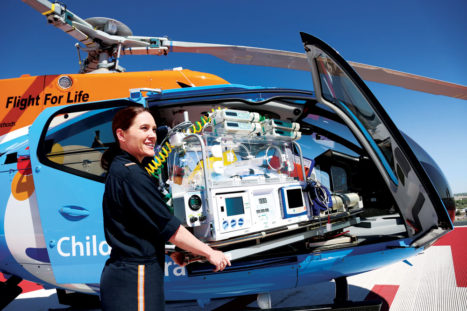
Lifeguard 6 is the newest addition to the Flight For Life Colorado (FFLC) fleet.
Newborn Aiden Castillo got a potentially life-saving ride on May 7 as the first patient in a new helicopter designed specifically for the transport of infants and young children. Aiden suffered from severe brain swelling resulting from a lack of oxygen to the brain during birth. Head-cooling therapy during flight was initiated to help reduce the swelling and its harmful side effects.

Flight R.N. Christy Tennant slides the pediatric incubator from the helicopter. Equipped with three ventilators, the incubator is capable of delivering 400-600 small puffs of air per minute and is staffed by a nurse and respiratory therapist in flight.
The helicopter is a “flying Neonatal Intensive Care Unit (NICU)” capable of stabilizing the tiniest patients in an incubator throughout transport to Children’s Hospital Colorado or other health care facilities, says Joe Darmofal, director of Flight Team, EMS, and Outreach and Education at Children’s Hospital Colorado. With its 50 percent larger cabin space and equipment for the specialized treatment of newborns, he says the helicopter is a tool that helps improve outcomes for pediatric patients.

Pilot Sam Creech flies above NE Denver.
Providing inter-facility health care transport for neonates and sick children, Lifeguard 6 is, quite literally, a lifesaver for rural families when children require highly specialized care unavailable in their communities. With a crew consisting of a pilot, nurse and respiratory therapist, the helicopter travels a 120-mile service area up and down the Front Range. It also serves communities in six neighboring states: Kansas, Nebraska, Wyoming, North and South Dakota, and Montana.
Based at Centennial Airport and capable of flying 140 mph, the helicopter is designed for optimal performance. “The enclosed tail rotor is a feature that makes this aircraft especially well-suited for pediatric transport,” says Darmofal. “Tiny premature infants can be prone to strokes and bleeding. Minimizing vibration in the aircraft during flight helps reduce this risk.” He also points out that the enclosure around the rotor prevents injury to the crew or health care providers who are near the helicopter on take-off and landing. The helicopter is also quieter than other models—an advantage in flight and for those on the ground.

FFLC Pilot dismbarks after a successful flight.
Darmofal says if inclement weather conditions are not compatible with flight, they use alternatives including ground transport with escorts from the Colorado Department of Transportation (CDOT), if needed. Emphasizing their commitment to safely transporting critically ill patients as quickly as possible, he adds, “We will find a way to get them where they’re going.”
The FFLC Airbus H130 T2 single-engine helicopter dedicated to transporting infants and young children took five years of planning and collaboration between Children’s Hospital Colorado, Flight For Life® Colorado (FFLC) and Centura Health. The first mission for Lifeguard 6 and its team on May 7 transported newborn Aiden Castillo from McKee Medical Center in Loveland to Children’s Hospital Colorado.
The air ambulance program, which began in 1972 at St. Anthony Hospital, is now part of the Centura Health network. Children’s Hospital Colorado began partnering to provide FFLC services in 1997. Making 4,000 program-wide flights per year, the new orange and blue helicopter is the seventh in the FFLC fleet and the only one specifically designed for specialized pediatric care.
Chopper from Steve Larson on Vimeo.



0 Comments